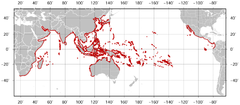Pelamis platurus
| Hydrophis platurus | |
|---|---|
 |
|
| Yellow-bellied sea snake | |
| Scientific classification | |
| Kingdom: | Animalia |
| Phylum: | Chordata |
| Subphylum: | Vertebrata |
| Class: | Reptilia |
| Order: | Squamata |
| Suborder: | Serpentes |
| Family: | Elapidae |
| Subfamily: | Hydrophiinae |
| Genus: |
Hydrophis Daudin, 1803 |
| Species: | H. platura |
| Binomial name | |
|
Hydrophis platura (Linnaeus, 1766) |
|
 |
|
| Yellow-bellied sea snake range | |
| Synonyms | |
|
|
Hydrophis platurus, commonly known as the yellow-bellied sea snake, yellowbelly sea snake or pelagic sea snake, is a species of snake from the subfamily Hydrophiinae (the sea snakes) found in tropical oceanic waters around the world, excluding the Atlantic Ocean. It was the only member of the genus Pelamis but recent molecular evidence suggests that it is more closely related to the species of the genus Hydrophis.
The yellow-bellied sea snake, as the name implies, has a distinctive bicolor pattern with a yellow underbelly and brown back, making it easily distinguishable from other sea snake species. Yellow-bellied sea snakes, like many other species of sea snake, are fully adapted to living their whole lives at sea: mating, eating and giving birth to live young (ovoviviparous). Adaptations to aquatic life include the reduced ventral scale size, laterally compressed body and paddle-tail for swimming, valved nostrils and palatine seal for excluding seawater, and cutaneous gas exchange for prolonging dive times. This species can uptake up to 33% of its oxygen requirements through the skin while diving and swimming at the surface of the water. Sea snakes also have a special salt gland located in the lower jaw that was formerly believed to filter out salt from the surrounding seawater but has been found not to be used for that purpose, as sea snakes drink fresh water only.
The body of this snake is compressed, with the posterior less than half the diameter of the neck; the body scales are juxtaposed, subquadrangular in shape, and in 23–47 rows around the thickest part of the body; ventral scales, 264–406 in number, are very small and, if distinct, divided by a longitudinal groove, but usually are indistinguishable from adjacent body scales. The head is narrow, with an elongated snout; head shields are entire, nostrils are superior, and nasal shields are in contact with one another; the prefrontal scale is in contact with second upper labial; one or two preoculars, two or three postoculars, and two or three small anterior temporals are present; seven or eight upper labials are found, with four or five below the eye, but separated from the border by a subocular. Colors of the snake are variable, but most often distinctly bicolored, black above, yellow or brown below, with the dorsal and ventral colors sharply demarcated from one another; ventrally, there may be a series of black spots or bars on the yellow or brown background, or the yellow may extend dorsally so there is only a narrow middorsal black stripe, or a series of black crossbars. Total length for males is up to 720 mm (28 in), for females up to 880 mm (35 in); tail length for males is up to 80 mm (3.1 in), females up to 90 mm (3.5 in).
...
Wikipedia

